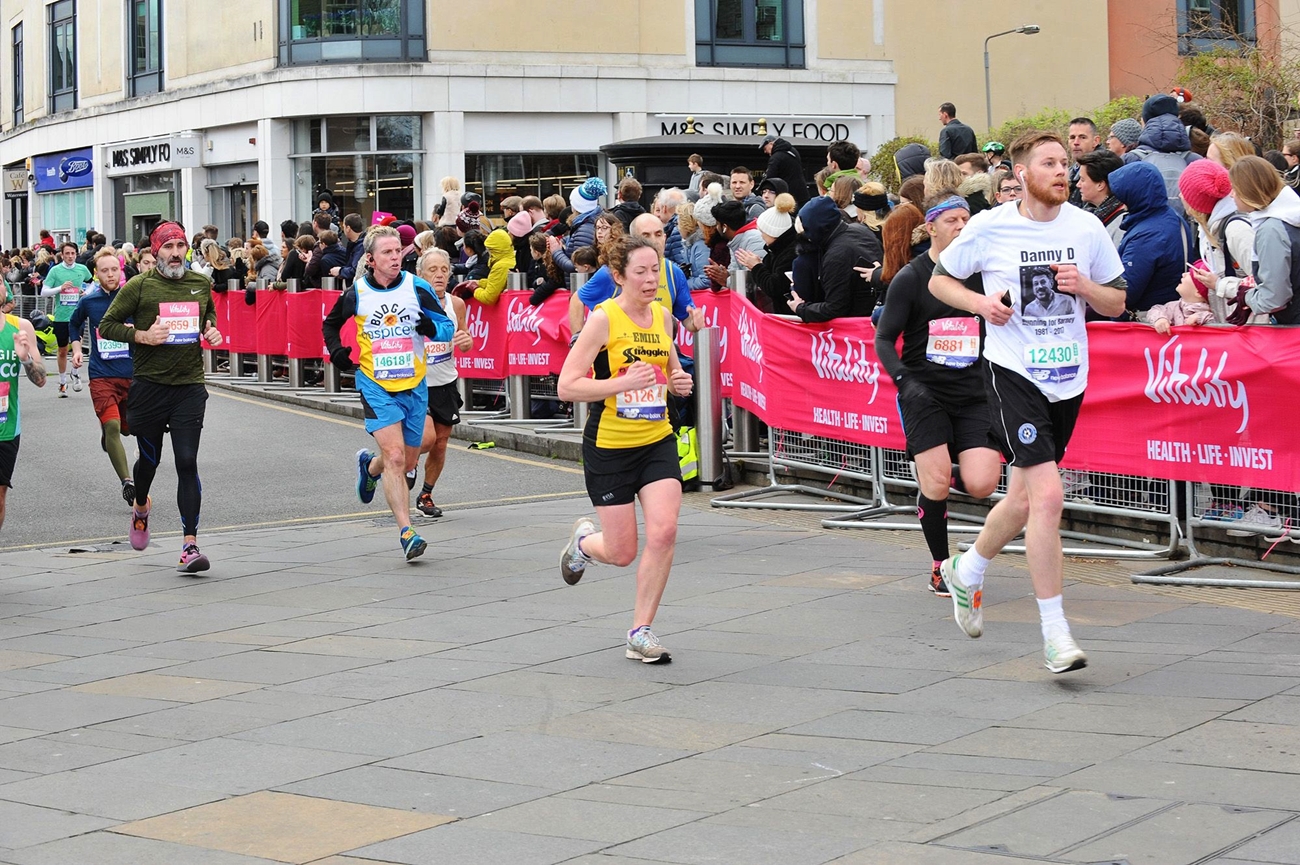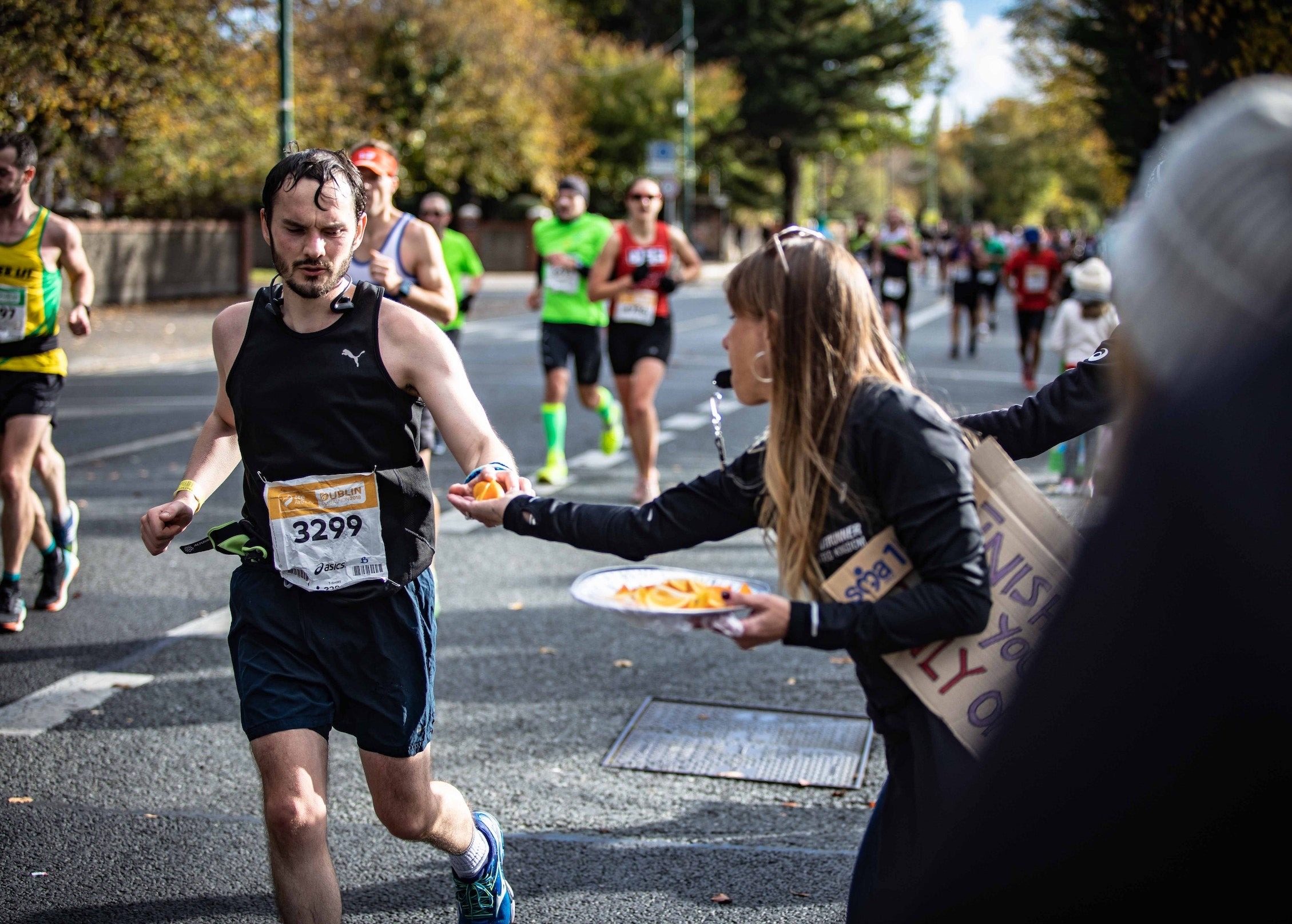

Featured
How To Run A 2 Hour Half Marathon
Modified: January 22, 2024
Discover the secrets to running a 2-hour half marathon with our featured guide. Master the techniques and strategies to achieve your personal best.
Introduction
Running a half marathon is an impressive feat that requires dedication, training, and mental fortitude. Completing a half marathon in 2 hours is an achievable goal for many runners, but it requires careful planning and preparation.
Whether you are a seasoned runner looking to set a personal record or a beginner aiming to finish your first half marathon within a specific time frame, this article will guide you through the steps to run a 2-hour half marathon.
Running a half marathon at a 2-hour pace requires a combination of endurance, speed, strength, and strategic planning. It’s essential to set realistic goals, develop a training schedule, and focus on various aspects of your running to maximize your performance on race day.
By following the tips and strategies outlined in this article, you’ll be well on your way to achieving your goal of running a 2-hour half marathon.
Before we dive into the details, it’s important to note that running is a highly individualized sport, and what works for one person may not work for another. It’s essential to listen to your body, make adjustments based on your own needs, and consult with a healthcare professional or a running coach if needed.
Now, let’s get started on the journey to running a 2-hour half marathon!
Setting a Realistic Goal
One of the first steps in preparing to run a 2-hour half marathon is setting a realistic goal. While aiming to complete the race in 2 hours is admirable, it’s important to consider your current fitness level, running experience, and previous race performances.
Take some time to evaluate your running abilities and assess your strengths and weaknesses. Consider factors such as your average pace in previous races, your training consistency, and the terrain of the race course.
Setting a realistic goal means finding a balance between a challenging target and one that is within your reach. It’s important to avoid setting an unrealistic goal that may lead to disappointment or injury.
Consider your current race times and use them as a benchmark. If your previous half marathon time is significantly slower than 2 hours, it may be more reasonable to work towards improving your time gradually over a series of races rather than aiming for a drastic improvement in a single attempt.
On the other hand, if you’re already close to the 2-hour mark, it might be feasible to set a more ambitious goal. Assess your performance in shorter races, such as 10Ks or 5Ks, to gauge your potential for achieving a 2-hour half marathon.
Remember that running is a journey, and progress takes time. Setting gradual and achievable goals can provide a sense of accomplishment and motivate you to continue improving.
Additionally, consider the external factors that can influence your race performance, such as weather conditions and elevation. If the race you’re planning to participate in has a challenging course or unfavorable weather forecast, adjusting your goal to reflect these conditions can help you stay realistic and adapt your strategy accordingly.
Ultimately, the key is to set a goal that is challenging but attainable based on your current abilities and circumstances. This will give you a sense of purpose and help guide your training plan as you work towards running a 2-hour half marathon.
Creating a Training Schedule
Once you have set your goal to run a 2-hour half marathon, the next step is to create a training schedule that will help you achieve it. A well-structured and consistent training plan is crucial for building endurance, increasing speed, and preventing injuries.
Start by determining the length of your training program. This will depend on your current fitness level and how much time you have before race day. Typically, a training period of 12-16 weeks is recommended for half marathon preparation.
Divide your training program into phases that focus on different aspects of your running. These phases may include base-building, endurance training, speed work, and tapering.
During the base-building phase, focus on increasing your weekly mileage gradually. This phase helps strengthen your cardiovascular system, builds endurance, and prepares your body for more intense training down the line.
Incorporate long runs into your schedule to improve your endurance. Gradually increase the distance of your long runs each week, aiming to reach at least 10-12 miles before race day. This will train your body to sustain the physical demands of running for a longer duration.
Once you have established a solid base, introduce speed work into your training routine. This can include interval training, tempo runs, and hill repeats. These workouts will help improve your running economy, increase your lactate threshold, and enhance your overall speed.
Make sure to include rest days in your training schedule to allow your body to recover and prevent overtraining. Recovery days are just as important as the training days and should not be neglected.
As you get closer to race day, enter the tapering phase. During this period, reduce your training volume while maintaining intensity. Tapering allows your body to rest and recover, ensuring that you are fresh and ready to perform your best on race day.
Remember to listen to your body. If you start experiencing persistent pain or fatigue, adjust your training schedule and consider seeking advice from a healthcare professional or running coach.
Consistency is key when it comes to training for a 2-hour half marathon. Stick to your training schedule as closely as possible and be diligent in completing your workouts. The more consistent you are, the better your chances of achieving your goal.
By creating a well-rounded training schedule that incorporates base-building, endurance, speed work, and tapering, you will be on track to running a 2-hour half marathon.
Focusing on Endurance Training
Building endurance is a crucial component of preparing for a 2-hour half marathon. Endurance training allows your body to efficiently sustain a faster pace for a longer period. Here are some key strategies to help you improve your endurance:
Long Runs: Incorporate weekly long runs into your training schedule. Begin with a comfortable distance and gradually increase it over time. Aim to reach at least 10-12 miles before race day. The long runs help build your aerobic capacity and mental strength to push through the latter stages of the half marathon.
Progressive Runs: Implement progressive runs into your training routine. Start your run at an easy pace and gradually increase your speed throughout the session. This trains your body to sustain a faster pace over an extended period, simulating the race conditions.
Tempo Runs: Tempo runs are shorter, faster-paced runs designed to improve your lactate threshold. This threshold is the point at which your body starts to accumulate lactic acid, leading to fatigue. By running at a comfortably hard pace for a sustained period, you increase your body’s ability to clear lactic acid, allowing for better endurance.
Consistent Training: Consistency is key when it comes to endurance training. Aim to run consistently throughout your training program, gradually increasing your weekly mileage. Consistent training allows your body to adapt and build the necessary endurance for a 2-hour half marathon.
Cross-Training: Incorporate cross-training activities such as cycling, swimming, or strength training to supplement your running. Cross-training helps prevent overuse injuries, improves overall fitness, and enhances your endurance by targeting different muscle groups.
Hill Training: Include hill training in your routine to build both strength and endurance. Running uphill challenges your muscles and cardiovascular system, preparing you for the demands of a hilly half marathon course. Incorporate hill repeats or find a hilly route for your training runs.
Pacing: During your endurance runs, practice running at your goal race pace. This will help you become familiar with the pace you need to maintain during the half marathon. Use a GPS watch or smartphone app to track your pace and ensure you’re on target.
Remember to listen to your body and rest when needed. Endurance training puts stress on your body, and adequate recovery is essential for progress. Incorporate rest days into your training schedule and include easy runs or cross-training activities to promote active recovery.
By focusing on improving your endurance through long runs, progressive runs, tempo runs, consistent training, cross-training, hill training, and practicing pacing, you will develop the necessary stamina to run a 2-hour half marathon.
Incorporating Speed and Interval Training
While endurance training is important for running a 2-hour half marathon, incorporating speed and interval training is equally vital. Speed work and interval training help improve your running economy, increase your lactate threshold, and enhance your overall speed. Here are some strategies to incorporate speed and interval training into your routine:
Interval Training: Interval training involves alternating between intense bursts of running and periods of active recovery. For example, run at a high intensity for a set distance or time, followed by a slower jog or walk to recover. Repeat this sequence for a specified number of repetitions. Interval training helps improve your anaerobic capacity, cardiovascular fitness, and running speed.
Track Workouts: Utilize a track for structured speed workouts. Perform exercises such as 400-meter repeats, where you run one lap around the track at a faster pace, followed by a recovery period. Adjust the number of repetitions and the pace based on your fitness level and goals. Track workouts help improve your speed and running efficiency.
Fartlek Runs: Fartlek, a Swedish term meaning “speed play,” involves incorporating bursts of faster running into your regular training runs. During a fartlek run, choose certain landmarks or objects, such as telephone poles or trees, and increase your pace until you reach each one. Then, return to your normal pace until the next landmark. Fartlek runs help improve your speed, stamina, and mental toughness.
Hill Repeats: Include hill repeats in your training program. Find a hill with a moderate incline and sprint uphill, focusing on driving your knees and pumping your arms. Recover on the way back down and repeat for a specified number of repetitions. Hill repeats help build explosive power, strengthen your leg muscles, and improve your overall speed.
Tempo Runs: Tempo runs, also known as threshold runs, involve running at a comfortably hard pace for an extended period. This pace is slightly slower than your race pace but faster than your easy runs. Tempo runs improve your lactate threshold, allowing you to sustain a faster pace for a longer period.
Progressive Runs: Incorporate progressive runs into your training routine. Start your run at an easy pace and gradually increase your speed throughout the session. This helps simulate the feeling of picking up the pace and finishing strong during a race.
Rest and Recovery: It’s important to balance your speed and interval training with rest and recovery. Pushing your body to its limits during intense workouts places stress on your muscles and joints. Allow adequate time for recovery and incorporate easy runs or cross-training activities into your schedule.
Remember to warm up before each speed or interval workout with dynamic stretches and a light jog, and cool down with a gentle jog and static stretches afterward. This will help prevent injuries and improve flexibility.
By incorporating speed and interval training into your routine through interval workouts, track workouts, fartlek runs, hill repeats, tempo runs, and progressive runs, you will develop the speed, power, and stamina needed to achieve a 2-hour half marathon.
Strengthening Your Muscles
Building strength is an essential component of training for a 2-hour half marathon. Strengthening your muscles helps improve running efficiency, prevent injuries, and enhance overall performance. Here are some strategies to incorporate muscle strengthening exercises into your training:
Strength Training: Incorporate strength training exercises into your routine to target your major muscle groups. Focus on exercises such as squats, lunges, deadlifts, calf raises, and hip bridges to strengthen your lower body. Include exercises for your upper body, such as push-ups, pull-ups, and shoulder presses, to improve overall body strength and stability.
Core Workouts: A strong core is essential for maintaining proper running form and stability. Incorporate exercises such as planks, Russian twists, bicycle crunches, and leg raises to strengthen your core muscles. Pilates and yoga can also help improve core strength and flexibility.
Resistance Bands: Utilize resistance bands in your strength training routine. These bands provide constant tension, challenging your muscles in a different way than traditional weights. They are versatile, portable, and can be used for various exercises targeting different muscle groups.
Plyometric Exercises: Plyometric exercises involve explosive movements that improve power and speed. Incorporate exercises such as box jumps, jump squats, and burpees into your training regimen. These exercises help improve your running economy and overall muscle strength.
Balance and Stability Exercises: Enhance your balance and stability with exercises like single-leg squats, lunges, and single-leg deadlifts. These exercises target the smaller stabilizer muscles in your legs, improving running efficiency and reducing the risk of injury.
Flexibility Training: Flexibility is crucial for injury prevention and efficient running form. Incorporate static stretching and dynamic stretches into your routine. Focus on stretching major muscle groups such as your calves, hamstrings, quadriceps, and hip flexors. Consider incorporating activities such as yoga or Pilates to improve flexibility and enhance overall body awareness.
Cross-Training: Engage in cross-training activities to strengthen muscles that are not targeted during running. Activities such as cycling, swimming, or using an elliptical machine can provide low-impact exercises that complement your running training. These activities help improve cardiovascular fitness, endurance, and overall muscular strength.
Form and Technique: Pay attention to your running form and technique. Seek guidance from a running coach or watch instructional videos to ensure proper alignment and minimize the risk of injury. Improving your running technique can help you become more efficient and reduce unnecessary strain on your muscles.
Remember to start with lighter weights or less resistance and gradually increase as your strength improves. Incorporate strength training sessions a few times a week, allowing for rest and recovery between sessions.
By incorporating strength training exercises, balance and stability exercises, flexibility training, and focusing on proper form and technique, you will strengthen your muscles, improve running efficiency, and enhance your overall performance in a 2-hour half marathon.
Proper Nutrition and Hydration
Nutrition and hydration play a crucial role in preparing your body for a 2-hour half marathon. Proper fueling before, during, and after your training runs and race day can improve your performance and aid in recovery. Here are some key considerations for optimal nutrition and hydration:
Pre-Run Fuel: Prior to your training runs and race day, consume a balanced meal that includes carbohydrates, protein, and a small amount of healthy fats. Carbohydrates provide the energy needed for endurance runs, while protein helps repair and rebuild muscles. Opt for easily digestible foods such as oatmeal, bananas, yogurt, and toast.
Hydration: Stay well-hydrated throughout your training program and on race day. Aim to drink at least 2-3 liters of water daily, adjusting based on your sweat rate and weather conditions. Use urine color as a guide; it should be pale yellow. During your long runs, consider carrying a water bottle or utilizing hydration belts or backpacks.
During-Run Fuel: For runs lasting longer than an hour, replenish your energy stores by consuming carbohydrates during the run. Experiment with different fueling options such as energy gels, chews, or sports drinks. Test these products during your training to ensure they work well for your body and don’t cause any gastrointestinal issues.
Post-Run Recovery: After completing your training runs, prioritize post-run recovery fueling. Consume a combination of carbohydrates and protein within 30-45 minutes of finishing your run to replenish glycogen stores and promote muscle recovery. Chocolate milk, a smoothie with protein powder, or a combination of whole foods like a turkey sandwich or Greek yogurt with fruit are good options.
Balanced Diet: Maintain a well-balanced diet throughout your training, including plenty of fruits, vegetables, lean proteins, whole grains, and healthy fats. These foods provide essential nutrients, vitamins, and minerals to support your overall health and performance.
Timing of Meals: Pay attention to the timing of your meals to optimize energy levels. Eat a balanced meal 2-3 hours before your training runs or race day to allow for digestion. For a smaller snack, consume it 30-60 minutes before running. Experiment with different timing to find what works best for you.
Supplementation: Consult with a healthcare professional or registered dietitian before considering any supplements. While certain supplements may be beneficial for some individuals, it’s best to obtain essential nutrients from whole foods whenever possible.
Individual Needs: Everyone’s nutritional needs are different, so listen to your body and adjust your fueling strategy accordingly. Pay attention to any dietary restrictions or intolerances you may have and find alternatives that meet your specific needs.
Remember to practice your nutrition and hydration strategies during your training to avoid any surprises on race day. Everyone is different, so it’s crucial to find what works best for your body through trial and error.
By fueling your body with proper nutrition and staying adequately hydrated, you will optimize your energy levels, enhance your performance, and ensure a successful 2-hour half marathon.
Rest and Recovery
Rest and recovery are often overlooked but are crucial aspects of training for a 2-hour half marathon. Giving your body time to rest and recharge is essential to prevent overtraining, reduce the risk of injury, and maximize performance on race day. Here are some important considerations for rest and recovery:
Rest Days: Include rest days in your training schedule to allow your body and mind to recover. Rest days give your muscles and joints time to repair and rebuild, reducing the risk of overuse injuries. Use these days for light stretching, foam rolling, or engaging in low-impact activities such as swimming or yoga.
Sleep: Prioritize getting quality sleep each night. Sleep is when your body repairs and regenerates tissues, releases growth hormones, and helps consolidate learning and memory. Aim for 7-9 hours of uninterrupted sleep to support your overall health and recovery.
Active Recovery: Incorporate active recovery into your training program. On rest days or after intense workouts, engage in activities that promote blood flow and aid in recovery. Gentle walks, easy bike rides, or light swimming can help flush out lactic acid and reduce muscle soreness.
Hydration and Nutrition: Proper hydration and nutrition are important for recovery. Drink plenty of water throughout the day to stay hydrated, and consume a balanced diet that includes carbohydrates, protein, and healthy fats. Focus on whole foods that provide essential nutrients to support muscle repair and replenish energy stores.
Stretching and Foam Rolling: Regular stretching and foam rolling can help improve flexibility, relieve muscle tension, and reduce the risk of injury. Incorporate dynamic stretches before your runs to warm up your muscles, and static stretches after your runs to cool down and lengthen tight muscles. Foam rolling can also help release muscle knots and adhesions.
Professional Help: Consider seeking professional help from a qualified physical therapist or sports massage therapist. They can provide targeted treatments and advice to aid in your rest and recovery. Regular sports massages can help relax tight muscles, improve blood circulation, and promote faster recovery.
Mental Rest: In addition to physical rest, mental rest is equally important. Running can be mentally challenging, and it’s important to give your mind a break. Practice mindfulness techniques such as meditation or engage in hobbies and activities that help you relax and recharge mentally.
Listen to Your Body: Pay attention to signs of fatigue, pain, or burnout. If you experience persistent or worsening symptoms, consider taking extra rest days or seeking guidance from a healthcare professional or running coach. Pushing through excessive fatigue and pain can lead to further injury or setbacks.
Remember that rest and recovery are not signs of weakness but rather essential components of a well-rounded training program. Incorporating these strategies will help you maintain a balance between training and recovery, leading to improved performance and a successful 2-hour half marathon.
Race Day Preparation
Race day is an exciting culmination of your training journey. Proper preparation and planning leading up to the event can help ensure a smooth and successful 2-hour half marathon. Here are some important tips to help you prepare for race day:
Tapering: Reduce your training volume in the final weeks leading up to the race. Tapering allows your body to rest, recover, and recharge, ensuring that you’re in peak condition on race day. Stick to your training plan, but gradually decrease the intensity and mileage of your runs.
Visualize Success: Spend time visualizing yourself crossing the finish line and achieving your goal of running a 2-hour half marathon. This mental preparation can boost your confidence and motivation on race day.
Race Gear: Lay out your race gear, including your running attire, shoes, and any accessories, the night before. Make sure everything is clean, comfortable, and familiar. Avoid trying anything new on race day to prevent discomfort or unexpected issues.
Nutrition Plan: Plan your pre-race meal and hydration strategy. Stick to familiar foods that you know will not cause digestive issues. Aim to eat your meal a few hours before the race to allow for digestion. Hydrate well but avoid overdrinking right before the race to minimize the need for bathroom breaks.
Arrival Time: Plan to arrive at the race location with plenty of time before the start. This gives you the opportunity to use the restroom, warm up, and mentally prepare. Research the race logistics, parking, and any potential road closures to avoid any last-minute stress.
Warm-Up: Perform a dynamic warm-up routine to gradually increase your heart rate, loosen your muscles, and prepare your body for the effort ahead. Include exercises such as jogging, high knees, butt kicks, lunges, and leg swings.
Pacing Strategy: Have a pacing strategy in mind based on your goal of running a 2-hour half marathon. Start conservatively and gradually increase your pace as the race progresses, aiming to finish strong in the last few miles. Use a GPS watch or the mile markers on the course to keep track of your pace.
Mental Focus: Stay mentally focused and positive throughout the race. Break it down into smaller segments or milestones to make it feel more manageable. Use strategic self-talk and positive affirmations to stay motivated and push through any challenges you may encounter.
Hydration and Fueling: Take advantage of the aid stations along the course to hydrate and fuel as needed. Stick to your planned race-day nutrition strategy, consuming familiar energy gels or sports drinks to maintain your energy levels. Practice this strategy during your training runs to ensure it works well for you.
Enjoy the Experience: Remember to enjoy the race day experience. Smile, acknowledge fellow runners, and take in the atmosphere around you. Running a 2-hour half marathon is a significant accomplishment, and every step brings you closer to achieving your goal.
Post-Race Recovery: After crossing the finish line, celebrate your achievement and take the time to properly recover. Continue walking to cool down, stretch gently, and refuel with a combination of carbohydrates and protein to aid in muscle recovery. Take pride in your accomplishment and bask in the sense of achievement that comes with completing a 2-hour half marathon.
By preparing for race day with careful planning, visualization, proper nutrition and hydration, and a positive mindset, you’ll be ready to tackle the 2-hour half marathon and create a memorable and successful running experience.
Running Strategies for a 2-Hour Half Marathon
Running a 2-hour half marathon requires a combination of physical endurance, mental resilience, and strategic planning. Here are some key running strategies to help you achieve your goal:
Start Slow: Begin the race at a conservative pace to conserve energy for the later miles. It’s easy to get caught up in the excitement and start too fast, which can lead to burnout later on. Gradually increase your pace as the race progresses.
Maintain Consistency: Aim for consistent splits throughout the race. Try to maintain a steady pace, especially during the middle miles when fatigue may start to set in. Use a GPS watch or mile markers on the course to monitor your pace and make any necessary adjustments.
Negative Split: A negative split means running the second half of the race faster than the first half. Aim to pick up your pace gradually in the later miles, staying strong and passing other runners. This strategy can help you maintain momentum and finish strong.
Stay Mentally Engaged: Keep your mind focused and engaged throughout the race. Break the race into smaller segments or milestones, and focus on one mile at a time. Visualization techniques, positive self-talk, and setting smaller goals can help you stay mentally strong and overcome any challenges.
Use Race Pacers: If available, consider running with a race pacer who can help you maintain a consistent pace and reach your goal time. Stick with the pacer and use them as a guide to help you stay on track.
Strategic Walk Breaks: Incorporate strategic walk breaks if needed. This can help you conserve energy and provide a momentary break for rejuvenation. Experiment with walk-run intervals during your training to find the strategy that works best for you.
Stay Hydrated: Take advantage of the water stations along the course and drink at regular intervals to stay well-hydrated. Consider carrying your own fluids if needed. Dehydration can negatively impact your performance, so make sure to find a hydration strategy that works for you during your training runs.
Mindful Breathing: Pay attention to your breathing and use it as a tool to regulate your pace and stay focused. Deep, controlled breaths can help calm your mind, provide oxygen to your muscles, and maintain a steady rhythm during the race.
Embrace Discomfort: Running a 2-hour half marathon will push you outside your comfort zone. Embrace the discomfort and be prepared to push through any physical or mental challenges that arise. Use the training and preparation you’ve put in to remind yourself that you’re capable of achieving your goal.
Stay Grateful and Enjoy: Remember to enjoy the experience and be grateful for the opportunity to run a half marathon. Cherish the journey, the sights, the sounds, and the camaraderie with other runners. Appreciating the process can help you stay positive and motivated throughout the race.
Every runner is unique, so it’s important to find the strategies that work best for you. Experiment with different techniques during your training runs to determine what helps you maintain your pace, stay focused, and reach your target time. With proper training and mindful execution, running a 2-hour half marathon is well within your reach.
Conclusion
Preparing to run a 2-hour half marathon requires commitment, dedication, and a well-planned strategy. By setting realistic goals, creating a structured training schedule, focusing on endurance and speed training, strengthening your muscles, prioritizing proper nutrition and hydration, allowing for sufficient rest and recovery, and implementing effective race day strategies, you will increase your chances of achieving your goal.
Remember that running is a personal journey, and what works for one person may not work for another. Listen to your body, adapt your training as needed, and seek guidance from professionals if necessary. Strive for progress rather than perfection, and celebrate the milestones along the way.
Running a 2-hour half marathon is a significant accomplishment, whether it’s your first time aiming for this goal or you’re a seasoned runner looking to achieve a personal best. The journey will require effort, perseverance, and mental resilience, but the sense of accomplishment and personal growth that comes with achieving your goal will make it all worthwhile.
So lace up your running shoes, embrace the training, and trust in your ability to reach that 2-hour half marathon finish line. With strategic planning, consistent effort, and a positive mindset, you’re well on your way to crossing that threshold and achieving a rewarding and memorable running experience.









